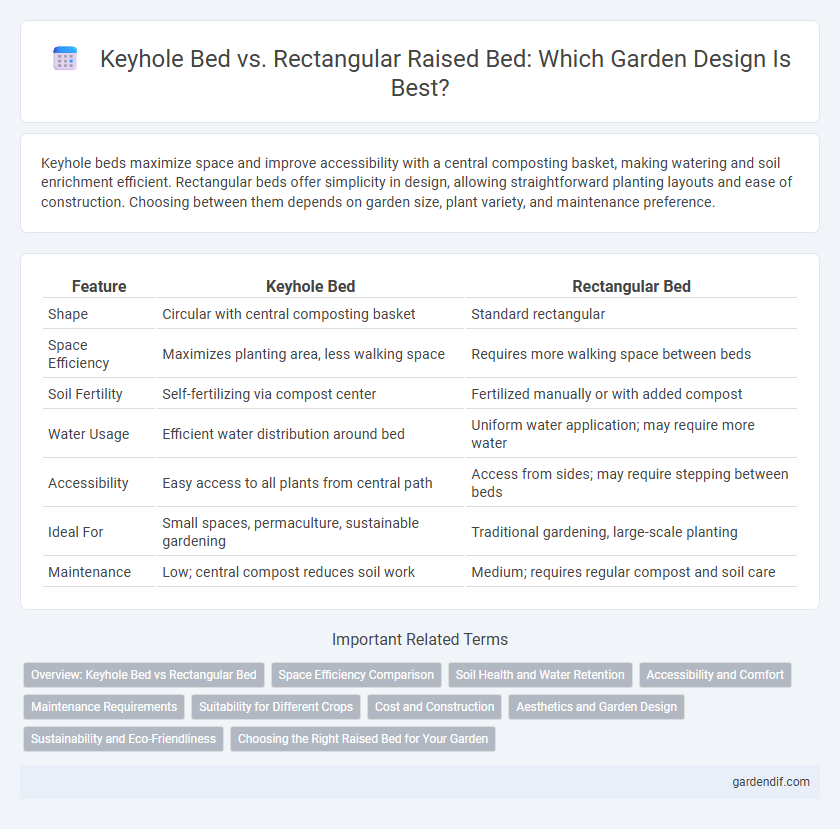
Keyhole bed vs Rectangular bed Illustration
Keyhole beds maximize space and improve accessibility with a central composting basket, making watering and soil enrichment efficient. Rectangular beds offer simplicity in design, allowing straightforward planting layouts and ease of construction. Choosing between them depends on garden size, plant variety, and maintenance preference.
Table of Comparison
| Feature | Keyhole Bed | Rectangular Bed |
|---|---|---|
| Shape | Circular with central composting basket | Standard rectangular |
| Space Efficiency | Maximizes planting area, less walking space | Requires more walking space between beds |
| Soil Fertility | Self-fertilizing via compost center | Fertilized manually or with added compost |
| Water Usage | Efficient water distribution around bed | Uniform water application; may require more water |
| Accessibility | Easy access to all plants from central path | Access from sides; may require stepping between beds |
| Ideal For | Small spaces, permaculture, sustainable gardening | Traditional gardening, large-scale planting |
| Maintenance | Low; central compost reduces soil work | Medium; requires regular compost and soil care |
Overview: Keyhole Bed vs Rectangular Bed
Keyhole beds feature a circular design with a central composting basket, optimizing nutrient recycling and water retention, while rectangular beds offer straightforward, space-efficient planting areas suitable for row cropping and intensive gardening. Keyhole beds are ideal for permaculture enthusiasts seeking sustainable, low-maintenance gardening, whereas rectangular beds provide easy access and flexibility for various garden layouts. Both designs support healthy plant growth but differ in shape, compost integration, and accessibility.
Space Efficiency Comparison
Keyhole beds maximize space efficiency by incorporating a central composting area for easy access and nutrient recycling, allowing more planting area within a compact footprint compared to rectangular beds. Rectangular beds offer straightforward layout and ease of construction but can waste space with less optimal access to the center, reducing usable planting area in smaller gardens. Choosing keyhole beds improves garden productivity by optimizing space allocation and minimizing walking paths.
Soil Health and Water Retention
Keyhole beds enhance soil health by promoting efficient nutrient recycling through central composting, leading to richer, more fertile soil compared to traditional rectangular beds. Their design improves water retention by directing water inward toward the plant roots, minimizing runoff and evaporation. Rectangular beds may require more frequent watering and careful soil amendment to maintain similar moisture levels and nutrient availability.
Accessibility and Comfort
Keyhole beds offer superior accessibility by allowing gardeners to reach all areas without stepping on the soil, promoting better plant health and ease of maintenance. Their circular design maximizes comfort through ergonomic spacing, reducing strain during planting and harvesting. Rectangular beds may provide more planting area but can compromise accessibility, especially for individuals with limited mobility.
Maintenance Requirements
Keyhole beds require less frequent weeding and soil disturbance due to their efficient circular design and centralized composting area, which enhances nutrient recycling. Rectangular beds demand more regular maintenance, including thorough weeding and soil turning, as their elongated shape can lead to uneven water distribution and nutrient depletion. Properly managing watering and soil amendments in rectangular beds is essential to prevent plant stress and maintain productivity.
Suitability for Different Crops
Keyhole beds excel in growing diverse crops that benefit from central watering and easy access, such as herbs, leafy greens, and root vegetables, due to their compact design and efficient water distribution. Rectangular beds offer greater flexibility for larger or row-planted crops like tomatoes, beans, and squash, providing ample space for root expansion and crop rotation. Crop selection in each raised bed style influences yield quality, soil health, and maintenance efficiency based on plant spacing and watering needs.
Cost and Construction
Keyhole beds generally require more complex construction with a circular design and a central composting area, often increasing initial costs due to specialized materials and labor. Rectangular beds feature straightforward, modular framing that lowers costs and simplifies assembly, making them ideal for budget-conscious gardeners. While keyhole beds optimize space and nutrient recycling, rectangular beds provide cost-efficiency and easier scalability in raised bed gardening.
Aesthetics and Garden Design
Keyhole beds offer a unique circular design with a central composting area, enhancing garden aesthetics through organic shapes and efficient space use. Rectangular beds provide a classic, structured look that complements traditional garden layouts and allows for straight planting rows, simplifying maintenance. Choosing between keyhole and rectangular beds depends on whether the preference is for innovative, visually striking designs or orderly, conventional garden organization.
Sustainability and Eco-Friendliness
Keyhole beds optimize water usage and minimize soil disturbance by concentrating compost at the center, promoting sustainable gardening practices. Rectangular beds offer straightforward construction and efficient space use but can lead to increased water runoff and soil erosion if not managed properly. Sustainable choices in raised bed design hinge on maximizing resource efficiency and minimizing environmental impact through smart layout and material selection.
Choosing the Right Raised Bed for Your Garden
Keyhole beds offer efficient space utilization and easy access to plants, making them ideal for small or irregular gardens, while rectangular beds provide maximum planting area suited for larger, linear spaces. Choosing the right raised bed depends on garden size, plant variety, and accessibility needs; keyhole beds reduce walking paths, enhancing soil health, whereas rectangular beds simplify irrigation and row planting. Prioritizing soil type, sunlight exposure, and maintenance preferences will ensure the selected raised bed optimizes growth and yield.
Keyhole bed vs Rectangular bed Infographic

 gardendif.com
gardendif.com